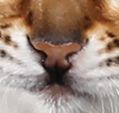
As a Bengal breeder when I am trying to understand a feature on my Bengals, I look to the small forest dwelling wildcats as a futuristic, or extreme, model of what to strive for. It isn't likely that the Bengal cat will ever achieve a nose like that of the small forest dwelling wildcats, but understanding their nose gives me direction. In addition, I find it very helpful to contrast features with ground dwelling cats of the Felis genus as the Felis cats are the root of all domestic cat breeds. In the collage above, the cats on the top are all Felis cats, both African and European wildcats, and the cats on the bottom are all forest dwelling wildcats; in this collage, they are all Asian Leopard cats.
There are three important aspect of the nose that all work together to create the look of the forest dwelling wildcat nose - size, shape, and set. For today, I am just going to talk about shape.
 The shape of a forest dwelling wildcat's nose is very distinct from the Felis cats, so this is a great aspect to emulate in the Bengal cat. To being with, look at the upper edge of the nose of the Asian leopard cats in the bottom row of the collage above. The small forest dwelling wildcats have a slight heart shape to the top line of the nose. It does not go straight across like the Felis cats.
The shape of a forest dwelling wildcat's nose is very distinct from the Felis cats, so this is a great aspect to emulate in the Bengal cat. To being with, look at the upper edge of the nose of the Asian leopard cats in the bottom row of the collage above. The small forest dwelling wildcats have a slight heart shape to the top line of the nose. It does not go straight across like the Felis cats. The most important distinction is shape, however, is the lower part of the nose. While the Felis cats tend to have a straight lower section of the nose that is equal in width or tapers to a point and the bottom edge of the noes. The Asian Leopard cat, in contrast, has a bottom flair. The bottom section of their nose flairs out again to offer a larger fleshy surface around the bottom of the nostril. As a nocturnal hunter, the small forest dwelling cats must utilize their sense of smell to find their prey, and the large fleshy, moist surface helps them use their nose to lead the to a meal.
When looking at your Bengal's nose, look for two key features of shape - the top line has a heart shape and the bottom has a flair to the flesh around the nostril.




